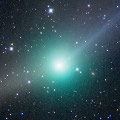
|
It kept as bright as 6-7 mag for a long time from 2011 summer to 2012 spring. Now it is fading. But it is bright as 9.1 mag still now (May 18, Marco Goiato). In the Northern Hemisphere, it will be unobservable at 10 mag in June. In the Southern Hemisphere, it is observable in the evening low sky from April to June.
Date(TT) R.A. (2000) Decl. Delta r Elong. m1 Best Time(A, h)
May 26 8 54.10 28 6.2 2.829 2.546 63 9.7 18:27 (154, 22)
June 2 8 57.16 25 58.0 3.003 2.613 58 10.0 18:25 (148, 22)
|

|
Big asteroid discovered in 1906. It suddenly showed the cometary activity on Dec. 11, 2010, probably due to an impact of a small object. Now it is 12.0 mag (May 27, Marco Goiato). It has already turned to be stellar.
Date(TT) R.A. (2000) Decl. Delta r Elong. m1 Best Time(A, h)
May 26 16 38.46 -21 8.5 1.435 2.445 173 11.9 0:25 (180, 76)
June 2 16 31.45 -21 45.1 1.432 2.446 177 11.8 23:45 (180, 77)
|
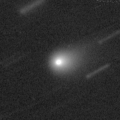
|
Already so bright as 12.1 mag (May 15, Carlos Labordena). It is expected to be bright as 9 mag from 2012 to 2013. In the Northern Hemisphere, it keeps observable in good condition for a long time until 2012 autumn when the comet brightens up to 10 mag. In the Southern Hemisphere, it is hardly observble before the perihelion passage. But it becomes observable in good condition since 2013 after the perihelion passage.
Date(TT) R.A. (2000) Decl. Delta r Elong. m1 Best Time(A, h)
May 26 14 29.07 54 13.5 2.905 3.261 101 12.0 22:10 (180, 1)
June 2 14 21.17 52 47.9 2.877 3.198 99 11.8 21:35 (180, 2)
|
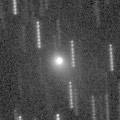
|
It brightened much faster than expected. Now it is so bright as 11.2 mag (May 14, Juan Jose Gonzalez). In the Northern Hemisphere, it keeps observable at 12-13 mag in good condition until early 2013. In the Southern Hemisphere, it is not observable until late 2012.
Date(TT) R.A. (2000) Decl. Delta r Elong. m1 Best Time(A, h)
May 26 2 32.89 85 15.3 2.480 2.241 64 12.8 5:26 (185,-33)
June 2 5 56.28 83 46.0 2.506 2.218 61 12.7 18:25 (173,-33)
|

|
Now it is 14.3 mag (Mar 13, Jakub Cerny). It is already unobservable in the Northern Hemisphere. In the Southern Hemisphere, it will be getting higher gradually. It is expected to be observable at 11-13 mag for a long time from 2012 summer to 2013 summer. It will be observable in excellent condition in the Southern Hemisphere. But it is not observable until 2013 January in the Northern Hemisphere.
Date(TT) R.A. (2000) Decl. Delta r Elong. m1 Best Time(A, h)
May 26 2 37.98 -38 32.6 2.983 2.690 63 13.2 5:26 (297, 32)
June 2 2 49.11 -40 23.6 2.853 2.641 67 13.0 5:30 (298, 36)
|
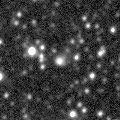
|
It is expected to be a great comet of -1 mag in 2013 spring. Now it is 13.3 mag (May 14, Todd Augustyniak). Brightening faster than originally expected. In 2012, it keeps observable until summer while brightening gradually. It locates somewhat low in the Northern Hemisphere.
Date(TT) R.A. (2000) Decl. Delta r Elong. m1 Best Time(A, h)
May 26 16 14.35 -25 54.3 3.508 4.518 175 13.3 0:01 (180, 81)
June 2 16 5.59 -25 54.1 3.436 4.441 171 13.2 23:19 (180, 81)
|
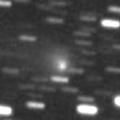
|
Now it is bright as 13.1 mag and visible visually (May 15, Juan Jose Gonzalez). It keeps 13-14 mag and observable in good condition until September.
Date(TT) R.A. (2000) Decl. Delta r Elong. m1 Best Time(A, h)
May 26 16 57.72 -12 42.5 4.150 5.140 166 13.4 0:44 (180, 68)
June 2 16 46.84 -12 34.5 4.141 5.143 170 13.4 0:06 (180, 68)
|
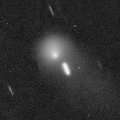
|
Now it is bright as 12.8 mag and visible visually (Mar. 14, John Drummond). It keeps bright as 13-14 mag for a long time after this until 2013. It is not observable in the Northern Hemisphere, but it is observable in good condition in the Southern Hemisphere.
Date(TT) R.A. (2000) Decl. Delta r Elong. m1 Best Time(A, h)
May 26 4 3.72 -54 42.9 5.720 5.560 75 13.6 5:26 (321, 25)
June 2 4 10.85 -54 3.7 5.718 5.570 76 13.6 5:30 (318, 28)
|
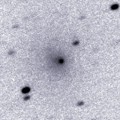
|
Another small outburst occured on May 1. Now it has got diffuse, but still visible as bright as 11.0 mag (May 14, Juan Jose Gonzalez).
Date(TT) R.A. (2000) Decl. Delta r Elong. m1 Best Time(A, h)
May 26 12 5.07 -10 24.4 5.689 6.257 119 13.7 19:48 (180, 65)
June 2 12 4.95 -10 15.9 5.786 6.256 113 13.8 19:20 (180, 65)
|
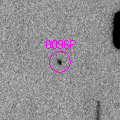
|
It has brightened up to 17.5 mag on May 15 (Martin Masek, et al.). Brightening rapidly. It will approach to the sun down to 0.12 A.U. on July 14. In the Southern Hemisphere, it keeps observable in good condition except for mid July only, in the morning sky before the perihelion passage, and in the evening sky after the perihelion passage. In the Northern Hemisphere, it is not observable before the perihelion passage. But it will appear in the evening sky at 8 mag in late July. Then it keeps observable while fading rapidly in the evening low sky.
Date(TT) R.A. (2000) Decl. Delta r Elong. m1 Best Time(A, h)
May 26 1 24.41 -33 49.1 1.279 1.300 67 14.6 5:26 (285, 45)
June 2 2 5.39 -31 18.6 1.151 1.172 65 13.8 5:30 (283, 42)
|

|
It kept as bright as 11-12 mag for a long time from 2011 autumn to 2012 spring. It is not observable now. But it will appear in the morning sky again at 15 mag in autumn.
Date(TT) R.A. (2000) Decl. Delta r Elong. m1 Best Time(A, h)
May 26 5 41.41 19 21.3 3.197 2.280 20 13.9 18:27 (114, 0)
June 2 5 56.82 19 22.2 3.249 2.306 18 14.0 18:25 (113, -2)
|

|
This comet brightened up to 10 mag in outburst in 1995, however, it became lost after that. The condition of this apparition is bad. It is not observable around the perihelion passage. Maybe it can be recovered after summer when it appears in the morning sky.
Date(TT) R.A. (2000) Decl. Delta r Elong. m1 Best Time(A, h)
May 26 3 6.68 10 28.4 2.399 1.478 18 14.1 5:26 (256, 1)
June 2 3 28.20 11 25.5 2.419 1.510 20 13.9 5:30 (254, 2)
|
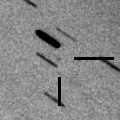
|
It will brighten up to 14 mag from May to July. It has not been observed since late January, but it must be already bright at 15 mag. In the Southern Hemisphere, it has been extremely low, but it will be getting higher gradually after this, and will be observable in good condition. It will be hardly observable in the Northern Hemisphere.
Date(TT) R.A. (2000) Decl. Delta r Elong. m1 Best Time(A, h)
May 26 3 20.04 -31 43.8 1.293 1.082 54 14.4 5:26 (294, 22)
June 2 3 52.97 -36 29.5 1.128 1.072 59 14.1 5:30 (299, 23)
|

|
Now it is so bright as 11.8 mag (May 14, Juan Jose Gonzalez). Although it was extremely faint as 20.5 mag at the recovery in 2010 autumn, it brightened rapidly. It will keep 12-14 mag and observable in good condition for a long time from 2012 to 2013. But it locates somewhat low in the Northern Hemisphere in 2013.
Date(TT) R.A. (2000) Decl. Delta r Elong. m1 Best Time(A, h)
May 26 12 51.10 12 44.9 2.528 3.160 120 14.2 20:33 (180, 42)
June 2 12 50.57 11 58.1 2.593 3.146 114 14.2 20:05 (180, 43)
|
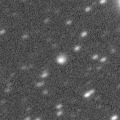
|
Now it is visible visually at 13.9 mag (Mar. 26, Jakub Cerny). It is expected to be 13 mag and will be observable in good condition in 2013. It keeps observable for a long time in the Northern Hemisphere. It is not observable in the Southern Hemisphere.
Date(TT) R.A. (2000) Decl. Delta r Elong. m1 Best Time(A, h)
May 26 23 27.77 52 45.6 6.832 6.419 61 14.3 5:26 (196, -1)
June 2 23 26.01 53 24.7 6.750 6.400 65 14.2 5:30 (191, 0)
|
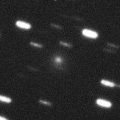
|
It was observed at 12.5 mag on Apr. 1, as bright as expected (Michael Jager). Now it is 14.0 mag (Apr. 26, Michael Jager). In the Northern Hemisphere, it locates extremely low in the morning until June. It will be observable at high location after summer. In the Southern Hemisphere, it will never be observable again.
Date(TT) R.A. (2000) Decl. Delta r Elong. m1 Best Time(A, h)
May 26 2 46.72 40 51.7 3.092 2.235 26 14.6 5:26 (229,-13)
June 2 3 4.36 41 50.8 3.151 2.307 28 14.8 5:30 (227,-12)
|
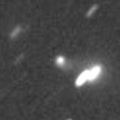
|
Now it is 14.9 mag (Apr. 1, Jakub Cerny). After this, it will be observable in good condition in the Southern Hemisphere while fading gradually. It will locate somewhat low in the Northern Hemisphere. In 2011, some visual observers reported it was very bright as 10-12 mag.
Date(TT) R.A. (2000) Decl. Delta r Elong. m1 Best Time(A, h)
May 26 22 50.68 -14 36.7 2.824 2.943 86 14.8 5:26 (222, 64)
June 2 22 57.23 -15 2.2 2.777 2.988 91 14.8 5:30 (209, 68)
|
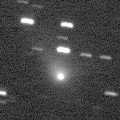
|
It brightened up to 9 mag in January and February in the evening low sky. In the Southern Hemisphere, it is observable in the evening extremely low sky in April and May. It will never be observable again in the Northern Hemisphere.
Date(TT) R.A. (2000) Decl. Delta r Elong. m1 Best Time(A, h)
May 26 5 30.72 2 50.2 2.557 1.711 26 15.1 18:27 ( 99, 8)
June 2 5 49.58 2 41.4 2.634 1.775 25 15.4 18:25 ( 98, 7)
|
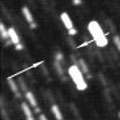
|
Now it is 16.0 mag (Mar. 26, Jakub Cerny). In the Southern Hemisphere, it will be observable at 15-16 mag in good condition for a long time until 2013 summer. It is not observable at all in the Northern Hemisphere.
Date(TT) R.A. (2000) Decl. Delta r Elong. m1 Best Time(A, h)
May 26 20 43.92 -63 46.7 3.374 3.959 118 15.1 4:29 ( 0, 61)
June 2 20 45.05 -66 14.7 3.320 3.949 121 15.1 4:03 ( 0, 59)
|

|
The condition of this apparition is bad, and it was not observable around the perihelion passage. Appearing in the morning sky now. It is bright still now, about 14 mag (May 16, Terry Lovejoy). But it still locates extremely low in the Northern Hemisphere.
Date(TT) R.A. (2000) Decl. Delta r Elong. m1 Best Time(A, h)
May 26 0 51.07 -2 41.8 2.569 2.148 54 15.2 5:26 (245, 35)
June 2 1 1.99 -1 40.3 2.541 2.187 58 15.3 5:30 (239, 38)
|
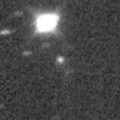
|
Now it is 16.1 mag (May 10, M. Jaeger, et al.). It will brighten up to 13.5 mag from summer to autumn. It keeps observable for a long time until December. In the Northern Hemisphere, it locates high until spring. But after that, it keeps locating low in the evening. In the Southern Henmisphere, it keeps locating low all through the time.
Date(TT) R.A. (2000) Decl. Delta r Elong. m1 Best Time(A, h)
May 26 10 54.84 34 43.2 2.023 2.204 86 16.0 18:38 (180, 20)
June 2 11 0.21 33 51.6 2.027 2.131 81 15.8 18:25 (178, 21)
|
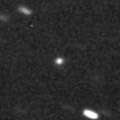
|
Bright new comet. Now it is 16.1 mag (May 14, P. Birtwhistle). It keeps observable in good condition at 14-15 mag for a long time until winter. It locates somewhat low in the Southern Hemisphere.
Date(TT) R.A. (2000) Decl. Delta r Elong. m1 Best Time(A, h)
May 26 23 2.69 27 45.2 3.904 3.676 69 16.1 5:26 (200, 24)
June 2 23 9.59 29 0.2 3.802 3.645 73 16.0 5:30 (194, 25)
|

|
First return of a new periodic comet which brightened up to 14 mag in 2005. It was recovered as bright as predicted. Now it is 17.5 mag (May 18, Martin Masek). It is expected to brighten up to 13 mag from summer to autumn, and will be observable in excellent condition. Now it locates high in the Southern Hemisphere.
Date(TT) R.A. (2000) Decl. Delta r Elong. m1 Best Time(A, h)
May 26 23 2.22 -20 29.0 1.653 1.883 86 16.9 5:26 (236, 67)
June 2 23 16.92 -18 48.0 1.555 1.842 89 16.7 5:30 (225, 68)
|
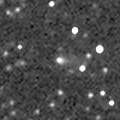
|
Now it is 16.3 mag (Apr. 24, V. Gerke, A. Novichonok, S. Plaksa). It tends to brighten after the perihelion passage. It keeps observable at 17 mag from 2012 to 2013. It locates somewhat low in the Northern Hemisphere.
Date(TT) R.A. (2000) Decl. Delta r Elong. m1 Best Time(A, h)
May 26 16 28.88 -15 31.2 2.117 3.126 173 16.7 0:15 (180, 71)
June 2 16 24.02 -15 39.9 2.115 3.123 172 16.7 23:38 (180, 71)
|
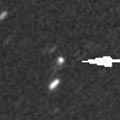
|
Now it is 16.9 mag (Apr. 14, Yasukazu Ikari). It is expected to keep 13 mag and observable in good condition in the Northern Hemisphere for a long time from 2013 to 2014. It will be low in June, and become unobservable for a while after July.
Date(TT) R.A. (2000) Decl. Delta r Elong. m1 Best Time(A, h)
May 26 10 22.68 12 41.1 6.042 6.089 87 16.8 18:27 (173, 42)
June 2 10 22.31 13 6.4 6.120 6.043 80 16.7 18:25 (165, 41)
|
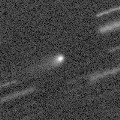
|
Now it is 16.7 mag (Apr. 14, Yasukazu Ikari). It keeps observable at 17 mag for a long time from 2011 to 2013. In 2012, it keeps observable in good condition until early September.
Date(TT) R.A. (2000) Decl. Delta r Elong. m1 Best Time(A, h)
May 26 15 9.02 8 11.1 4.746 5.622 146 16.9 22:50 (180, 47)
June 2 15 0.33 8 23.6 4.800 5.622 140 16.9 22:14 (180, 47)
|
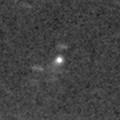
|
Now it is 16.7 mag (Apr. 21, Catalina Sky Survey). In the Northern Hemisphere, it keeps observable at 16-17 mag in good condition for a long time from 2012 to 2013. It is not observable in the Southern Hemisphere.
Date(TT) R.A. (2000) Decl. Delta r Elong. m1 Best Time(A, h)
May 26 8 58.46 63 28.4 4.186 3.834 62 16.9 18:27 (168,-11)
June 2 8 55.76 62 56.4 4.241 3.810 58 16.9 18:25 (165,-11)
|
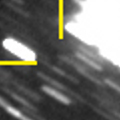
|
It has not been observed since 2011 March. Juro Kobayashi detected a possible image of this comet at around 19 mag on Apr. 28. It is predicted to brighten up to 17 mag and will be observable in good condition from spring to summer. But actually, it seems much fainter than expected.
Date(TT) R.A. (2000) Decl. Delta r Elong. m1 Best Time(A, h)
May 26 19 36.57 -7 5.1 1.378 2.161 128 17.0 3:22 (180, 62)
June 2 19 36.50 -6 28.5 1.341 2.178 134 17.0 2:54 (180, 61)
|

|
Hidetaka Sato observed it at 18.6 mag on May 27. It is expected to brighten rapidly and to reach up to 10 mag in August. It keeps observable in the morning sky all through this apparition, although it locates somewhat low.
Date(TT) R.A. (2000) Decl. Delta r Elong. m1 Best Time(A, h)
May 26 23 24.65 11 9.9 1.451 1.446 69 17.7 5:26 (213, 38)
June 2 23 49.91 13 52.4 1.366 1.380 69 17.0 5:30 (210, 36)
|
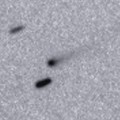
|
Now it is 16.4 mag (Apr. 15, J. F. Hernandez). It will brighten up to 13 mag in 2014. In 2012, it is observable at 17 mag in good condition in spring.
Date(TT) R.A. (2000) Decl. Delta r Elong. m1 Best Time(A, h)
May 26 10 55.27 15 54.7 3.978 4.172 93 17.2 18:38 (180, 39)
June 2 10 57.47 15 24.2 4.067 4.157 87 17.2 18:25 (176, 40)
|
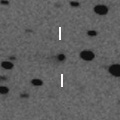
|
It keeps 17 mag for a long time from 2009 to 2013.
Date(TT) R.A. (2000) Decl. Delta r Elong. m1 Best Time(A, h)
May 26 23 41.73 13 45.3 8.685 8.299 64 17.4 5:26 (216, 33)
June 2 23 41.05 13 57.2 8.584 8.310 71 17.4 5:30 (207, 37)
|

|
Dave Herald observed it at 18.6 mag on May 27. It will approach to the earth down to 0.17 A.U. in July. Then it brightens up to 15 mag and moves northwards very quickly. Now it locates very high in the Southern Hemisphere, but not observable in the Northern Hemisphere. In the Northern Hemisphere, it will become observable in late June, then it will be observable in excellent condition. In the Southern Hemisphere, it keeps excellent condition until July. It keeps observable also after that, but locates somewhat low.
Date(TT) R.A. (2000) Decl. Delta r Elong. m1 Best Time(A, h)
May 26 17 32.50 -61 47.2 0.421 1.352 137 17.9 1:18 ( 0, 63)
June 2 17 44.82 -60 19.0 0.363 1.314 140 17.5 1:03 ( 0, 65)
|
|
![]()
 C/2011 U3 ( PanSTARRS )
C/2011 U3 ( PanSTARRS ) 246P/2010 V2 ( NEAT )
246P/2010 V2 ( NEAT ) C/2010 S1 ( LINEAR )
C/2010 S1 ( LINEAR ) C/2011 Q2 ( McNaught )
C/2011 Q2 ( McNaught ) C/2011 A3 ( Gibbs )
C/2011 A3 ( Gibbs ) 21P/Giacobini-Zinner
21P/Giacobini-Zinner C/2011 O1 ( LINEAR )
C/2011 O1 ( LINEAR ) 71P/Clark
71P/Clark C/2012 CH17 ( MOSS )
C/2012 CH17 ( MOSS ) C/2012 J1 ( Catalina )
C/2012 J1 ( Catalina ) 258P/2012 K2 ( McNaught )
258P/2012 K2 ( McNaught ) 152P/Helin-Lawrence
152P/Helin-Lawrence C/2011 J2 ( LINEAR )
C/2011 J2 ( LINEAR ) C/2010 R1 ( LINEAR )
C/2010 R1 ( LINEAR ) C/2012 A2 ( LINEAR )
C/2012 A2 ( LINEAR ) 105P/Singer Brewster
105P/Singer Brewster 185P/Petriew
185P/Petriew 117P/Helin-Roman-Alu 1
117P/Helin-Roman-Alu 1 C/2008 S3 ( Boattini )
C/2008 S3 ( Boattini ) 189P/NEAT
189P/NEAT![]()



























